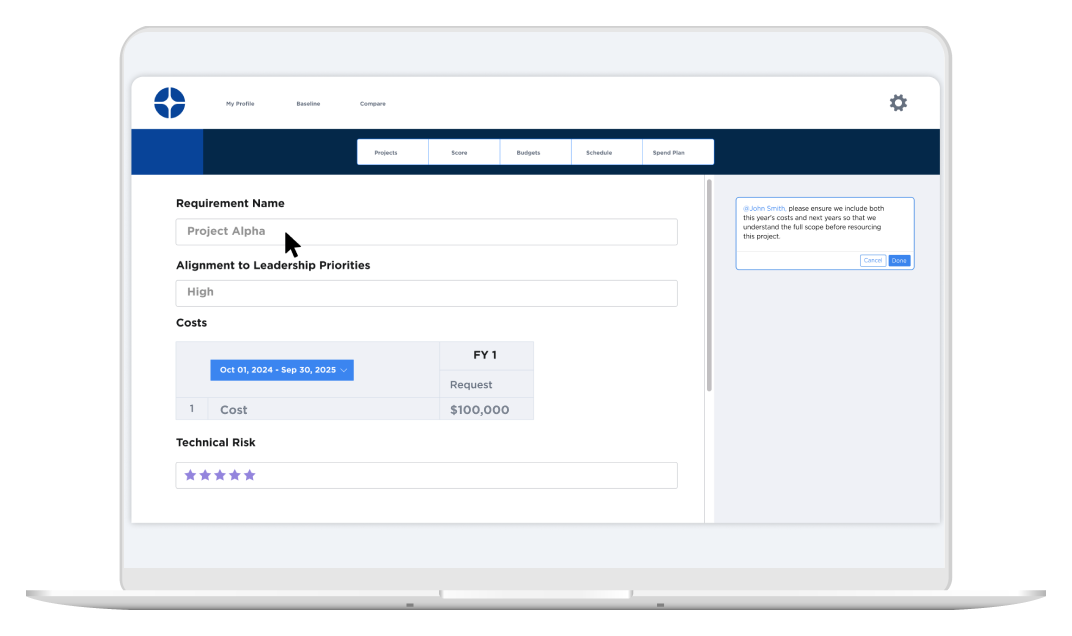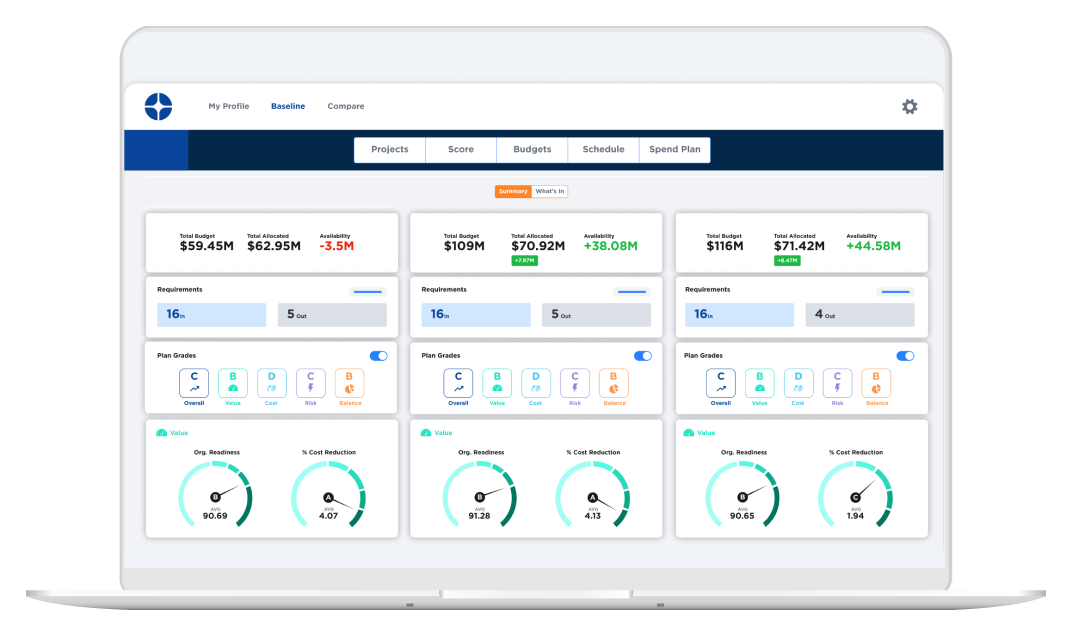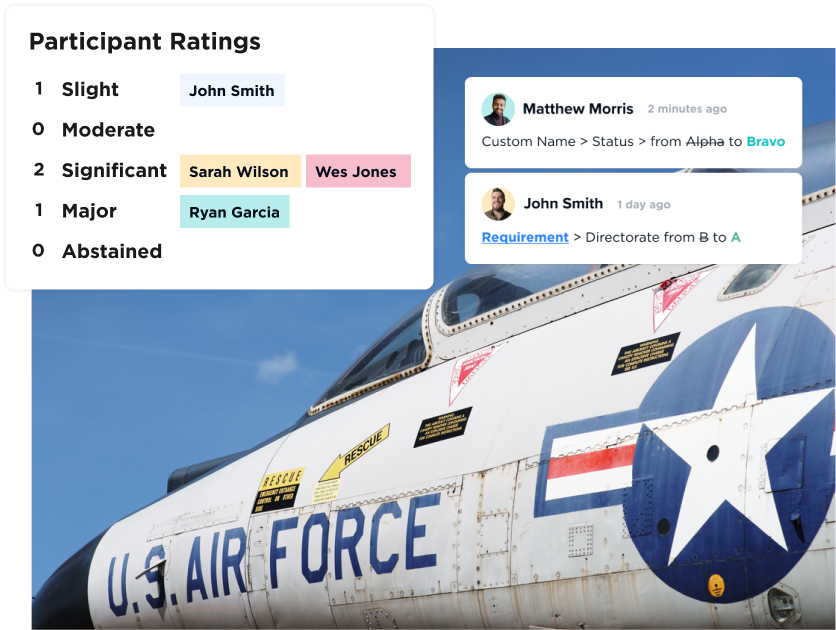In this article
In the era of Great Power Competition (GPC), the U.S. Air Force faces unprecedented challenges in resource allocation, highlighting the need for an agile, data-driven, planning and decision-making process. As China, our top global competitor, rapidly advances their military capabilities through faster, more agile funding processes, the Air Force's traditional planning and budgeting processes within the PPBE ecosystem are struggling to keep pace. This article explores how outdated technologies, tools, and processes are hindering the Air Force's ability to make agile resourcing decisions, and how modern software solutions can better address these challenges.
The Resourcing Dilemma in Great Power Competition
The Air Force finds itself at a critical juncture, grappling with resource allocation challenges rooted in outdated methodologies. The Air Force, like many other DoD organizations, relies on manual processes that have long outlived their effectiveness.
A culture of low risk tolerance in the DoD, bureaucratic hurdles, a cumbersome PPBE process, and a limited ability to quickly invest in modernization programs have left the Air Force with resourcing systems and planning tools that do not meet its needs quickly or efficiently. These legacy systems, though familiar, are wholly incapable of allowing the Air Force to keep up with China’s unrelenting pace of technology investments. As the PPBE Reform Commission, from a legislative perspective, has laid out why and how DoD resourcing tools and systems should be modernized, the Air Force needs software that can deliver the decision advantage in GPC now.
When it comes to making decisions about how to prioritize resources, invest in technologies, and advance the mission, Air Force planners and program managers must analyze vast amounts of complex data from multiple, disconnected sources. Continuing to rely on manual, time-consuming processes and outdated tools to make resourcing decisions erodes our deterrence advantages and hinders efforts to build the Air Force of the future.
Obsolete software and planning tools rob us of the speed and flexibility to keep pace with China's rapid research, investment, and development of new technologies and weapon systems, as demonstrated by China’s creation of 25 new unmanned aircraft systems between 2010 and 2020. This is one of the greatest current risks of GPC – by the time Air Force leaders have the necessary information to make a resourcing decision, new Chinese threats or capabilities may have emerged that make current plans irrelevant.
The Pitfalls of Manual Tools and Processes
Traditional planning tools like siloed databases, spreadsheets, and static reports are too error-prone, demand too much manual labor, and, above all, take up too much time – a resource the Air Force has precious little of in today’s heightened threat environment. Even if these processes were error-proof, China’s technological pace of change may have already made the decision irrelevant. With the resurgence of GPC, these mistakes and inefficiencies are unaffordable and intolerable.
Manual processes prioritize data collection and validation over analysis, leading to overinvestment in low-value tasks, employee disengagement, and delayed decision-making.
There are four reasons why relying on manual, repetitive processes damages Air Force preparedness and modernization:
1. Humans make mistakes
Manual data handling is error-prone – mistakes as simple as duplicative copy & pastes, broken macros, erroneous functions, or accidental data deletion all increase the risk of incorrect situational assessments, resulting in poor decisions, missed technological investment opportunities, and an Air Force unprepared to counter emerging Chinese threats
2. Resource-intensive tasks
Resource-intensive tasks drain precious time and manpower from more strategic activities. Come crunch time, financial managers may not have enough time to conduct more essential analysis to help inform decisions. Furthermore, tedious and repetitive tasks can lead to workforce retention issues, putting even more pressure on already strained FM personnel.
3. Static Reports
Static reports become quickly outdated, impeding accurate decision-making. This problem is further intensified by GPC, where threats and rival technologies evolve at increasingly rapid rates and further erode the Air Force’s strategic and tactical advantages.
4. Duplicate Data
Manual, spreadsheet and email-based processes often lead to duplicate versions of data quickly multiplying or getting lost, leading to slow response times or decisions based on data that isn’t up to date. This results in slower, poorer decisions.The Air Force cannot rely on sheer brute force to meet or exceed China’s pace of modernization, partly because its traditional planning tools demand too much manual labor, weaken or delay analytics activities, and take up too much time to meet the demands and pace of modern GPC.
Introducing Commercial-Off-the-Shelf Solutions
In the high-stakes arena of Great Power Competition, the Air Force does not have the luxury of time to develop software solutions in-house. Commercial Off-The-Shelf (COTS) solutions offer a strategic advantage, rapidly integrating cutting-edge private sector innovations into Air Force capabilities. These solutions dramatically reduce development time and costs, critical factors in matching China's relentless pace of military modernization. COTS products, honed in competitive markets, deliver continuous improvements without burdening Air Force resources. They enable swift deployment of new capabilities, essential for adapting to evolving threats in an era where technological superiority determines battlefield outcomes.
As security remains paramount, many vendors now tailor their offerings to meet rigorous DoD standards. By leveraging COTS, the Air Force can concentrate its limited resources on mission-critical tasks and customizations, rather than reinventing common IT functions. With the right vendor, COTS solutions can be viable on Air Force networks through an ATO out of the box, with an implementation time of weeks rather than months or even years. In this race against time, adopting commercial innovations isn't just efficient – it's imperative for preserving America's air superiority and strategic edge in Great Power Competition.
Given the advantages of COTS solutions, it's important to examine the specific capabilities these platforms can offer. Modern software solutions designed for agile planning and data-informed decision-making provide a range of features that directly address the resourcing challenges faced in GPC.
COTS solutions offer 6 key abilities that deliver the decision advantage. By leveraging these capabilities, the Air Force can significantly enhance its decision-making processes and resource optimization.
1. Data Integration and Real-Time Analysis

Modern software can integrate data from various sources, providing a unified view of resources and requirements. This enables real-time analysis and more informed decision-making, crucial for keeping pace with rapid technological advancements in the year of budget execution or for aligning budgets and programs with long-term strategic goals.
2. Scenario Planning and Agile Resource Allocation

Advanced tools allow for quick scenario modeling and "what-if" analyses, enabling the Air Force to rapidly assess different resource allocation strategies in response to emerging Chinese threats or wider security needs in the pacific. Alternatively, scenario planning also mitigates uncertainty for long-term, strategic planning during the POM process, enabling analysis of multiple future financial and geopolitical scenarios using a clear, flexible decision-making framework.
3. AI-Driven Insights
With the right use of AI and Machine Learning, modern software can introduce automation into financial analysis, yielding optimized resource allocation plans based on real-time data and qualitative scoring and weighting.
4. Collaborative Decision-Making

Modern platforms facilitate collaboration among stakeholders, breaking down silos and ensuring that all relevant perspectives are considered in the planning process. This ensures that decision-makers can receive input on future requirements or current portfolio health at scale and across many perspectives up and down the chain of command, leading to well-rounded resourcing decisions that best counter threats over long-, mid-, and short-range time horizons.
5. Automated Workflows
By automating many of the manual processes currently relied upon, new software solutions can significantly reduce the time and effort required for planning and budgeting, allowing for more frequent updates and adjustments.
6. Enhanced Transparency and Accountability
Advanced software provides a clear audit trail of decisions and their rationale, improving transparency and accountability in the resource allocation process.
Final Thoughts
In its final report, the PPBE Reform Commission called China a “pacing threat” (Final Report, P. 1). Our current pace of innovation and adoption is drastically too slow to match or overmatch China’s ability to rapidly and continuously modernize its military and deploy new weapons. Across the PPBE process, from planning, to POM, to execution, traditional planning tools like static spreadsheets and siloed data systems increase the risk of erroneous resourcing decisions.
As the Air Force tackles the challenges of Great Power Competition, modernizing its resourcing processes is no longer optional—it's a strategic imperative. Modern, agile, collaborative, and data-driven prioritization and planning tools are a necessity to develop and sustain mission-aligned capabilities quickly and effectively, for both short-term readiness and long-term innovation. In 2024, Air Force Chief of Staff Gen. David Allvin released the 'Case for Change' document, which states that optimizing capability development requires “streamlined decision-making, data-driven prioritization, and the integration of emerging technology across the Air Force.”
By adopting advanced software solutions, the Air Force can enhance its ability to make rapid, data-driven decisions, optimize resource allocation, and maintain its competitive edge.
Integrated, data-driven planning software enables leaders and managers to make informed, agile resource allocation decisions and ensures that the Air Force can adapt quickly to emerging threats and shifting strategic priorities. Modern planning and budgeting software is not merely an optional, operational asset—it's a strategic necessity that enables the agility and foresight required to stay ahead in the fast-paced environment of global competition. By leveraging cutting-edge tools for resource management, the Air Force can optimize its investments, enhance its readiness, and maintain the decisive edge necessary for success in Great Power Competition.
A Word About Decision Lens
Decision Lens revolutionizes government planning through integrated software that modernizes prioritization, planning, and funding processes. Since 2005, we've been at the forefront of transforming public sector planning, equipping agencies with the tools to meet current needs while developing future capabilities.
Our comprehensive approach combines cutting-edge technology, expert personnel, and streamlined processes. This enables our clients to achieve a sustained operational advantage through:
- Superior long-term planning
- Continuous medium-term prioritization
- Efficient short-term funding execution
Our diverse client base spans the Department of Defense, intelligence community, federal civilian agencies, and state and local governments. By choosing Decision Lens, these organizations enhance their ability to make data-driven, mission-aligned decisions in an increasingly complex world.




